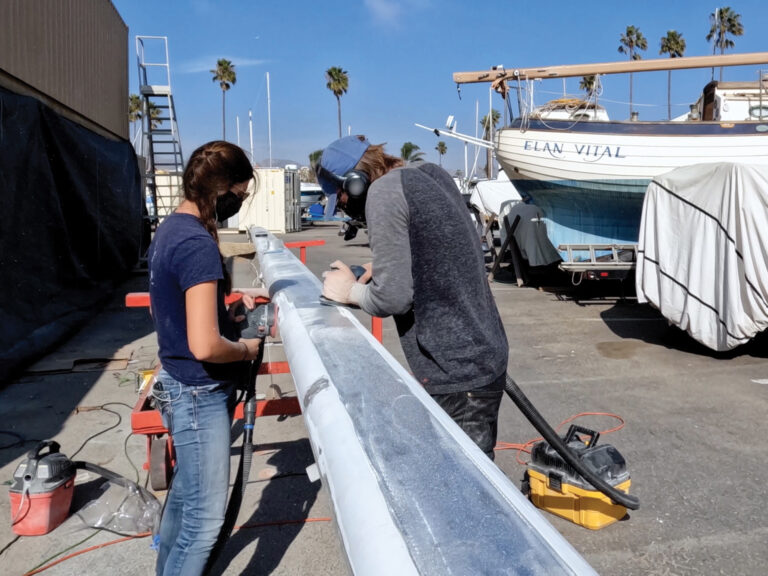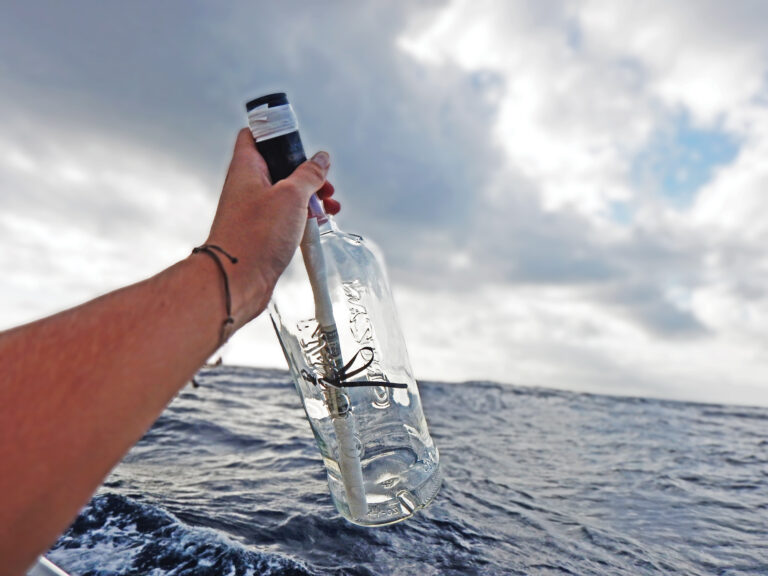
Powerful storms that pounded the northern Caribbean, Florida and Texas last fall were potent reminders that severe weather causes severe damage. Still, every dark cloud has a silver lining. As insurance claims are paid out and piles of vessels are untangled, hundreds (perhaps thousands) of handyman skippers are going to end up with amazing boats, literally for pennies on the dollar. I know of which I speak. My wife, Carolyn, and I purchased the salvage rights to a Hughes 38 found sunk on the beach after Hurricane Hugo struck the Virgin Islands in 1989 for $3,000 — then fixed her up and sailed her twice around the world. Wild Card certainly wasn’t the most pristine yacht we saw in the 100,000 ocean miles we sailed her over the course of 23 wonderful years, but at an initial cost of 3 cents per mile, she was certainly among the cheapest. The problem with buying a hurricane-damaged fiberglass sailboat is that a good buy can look like it is practically worthless, and a worthless vessel can look like a good buy. So the first concept you need to understand is that you’re not only buying a boat, you’re buying a tremendous liability as well. And once you buy it, the only way out involves either a pile of cash or a lot of blood, sweat and tears, sustained over a long period of time.
The first priority of a successful salvage is finding a wrecked boat that looks bad and thus sells cheap, but is actually fairly straightforward to remove and repair.
When it comes to salvage, tenacity is the key. If in doubt, don’t. I repeat: Only masochists need apply.
However, big risks can equal big gains, and each deal is unique. I’ve seen insured boats with barely any damage sitting atop uninsured boats that were totally crushed. The owner of the insured boat says shrilly, “She’s totaled!” Meanwhile, the crushed boat’s owner says, “I think I can fix her. It’s really just cosmetic!”

The first priority of a successful salvage is finding a wrecked boat that looks bad and thus sells cheap, but is actually fairly straightforward to remove and repair. Reinvigorating a vessel doesn’t only include the expense of buying the materials and smearing them on; transportation and shipyard costs must be factored in as well.
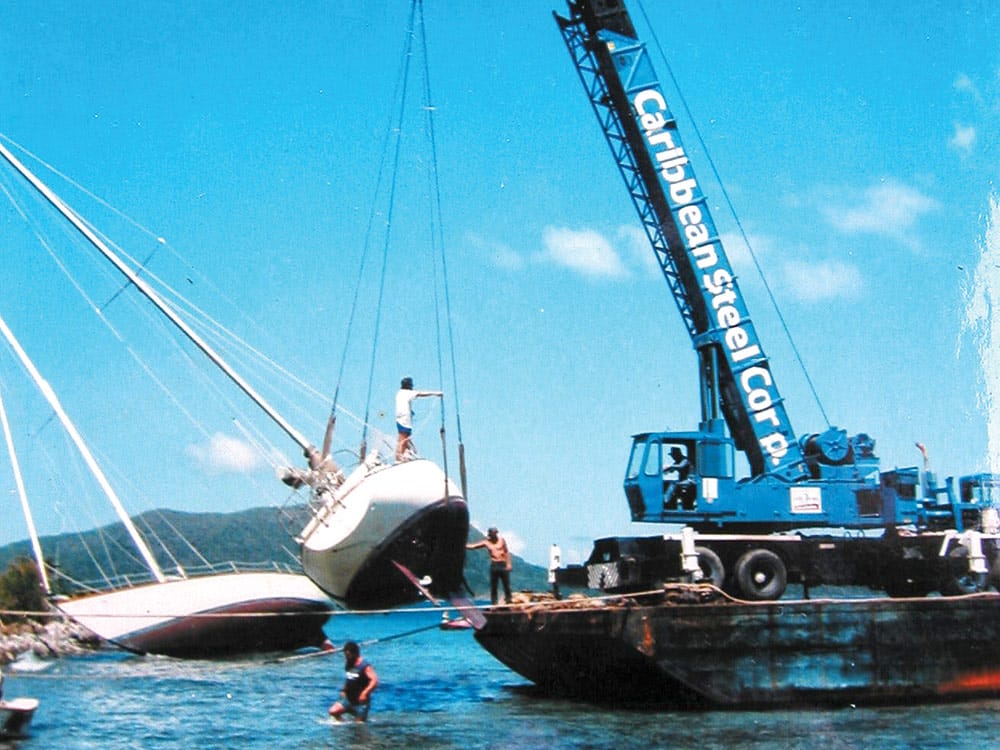
Some of the best deals happen fast, as each passing day, more and more sanity enters the marketplace. My buddy Kevin Rowlette, aboard Husky, was hired to drag a damaged Beneteau from the beach into deep water to sink it. But, instead of scuttling it, he tossed a single dollar bill at the owner as he attached his towline to the vessel. He eventually repaired it, and it became the famous Fast Buck. We sailed together during many a regatta. In fact, I think we did the entire Caribbean Ocean Racing Triangle series on it in the early 1990s, and every time Kevin would buy me a beer, he’d lament, “Damn, that’s twice what I paid for the boat, Fatty!”
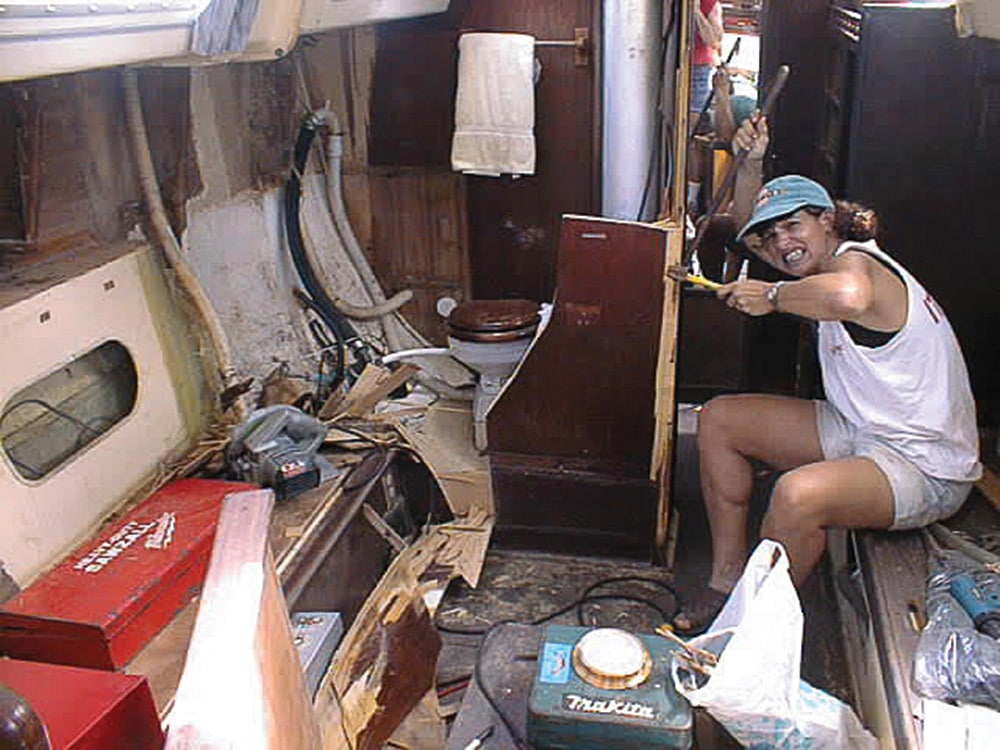
Many people are scared by holes through the hull. Don’t be. These can be fixed easily if they are of small to moderate size and the boat hasn’t lost its shape. Use clear-cedar battens inside the vessel to maintain a fair curve as you fiberglass. Start outside, then once the shape is locked in, you can remove the battens and finish the repair on the inside.
There are certain types of damage to avoid: snapped-off rudder skegs; displaced keels; severe hull-to-deck-joint damage; smashed-off bows; crushed or cracked stems; and any damage that displaces such things as the engine, propeller shaft, mast step or rudder.
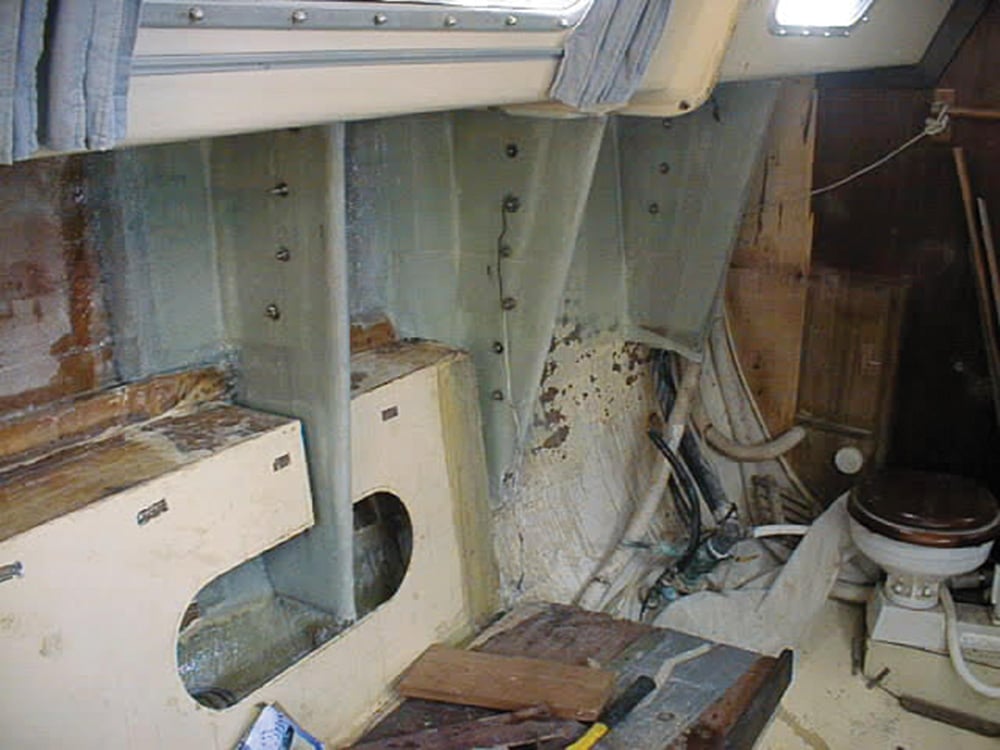
A vessel sunk for a day or two is a problem. A vessel underwater for more than a couple of weeks is a nightmare. Why? Because everything mechanical and electrical will have to be thrown away. In addition, all the wood will delaminate, swell, split and crack, meaning you’ll have to replace all the structural bulkheads, chainplate webs, mast steps and, of course, the entire interior.
That aside, the good news is that any fiberglass boat can be fixed.
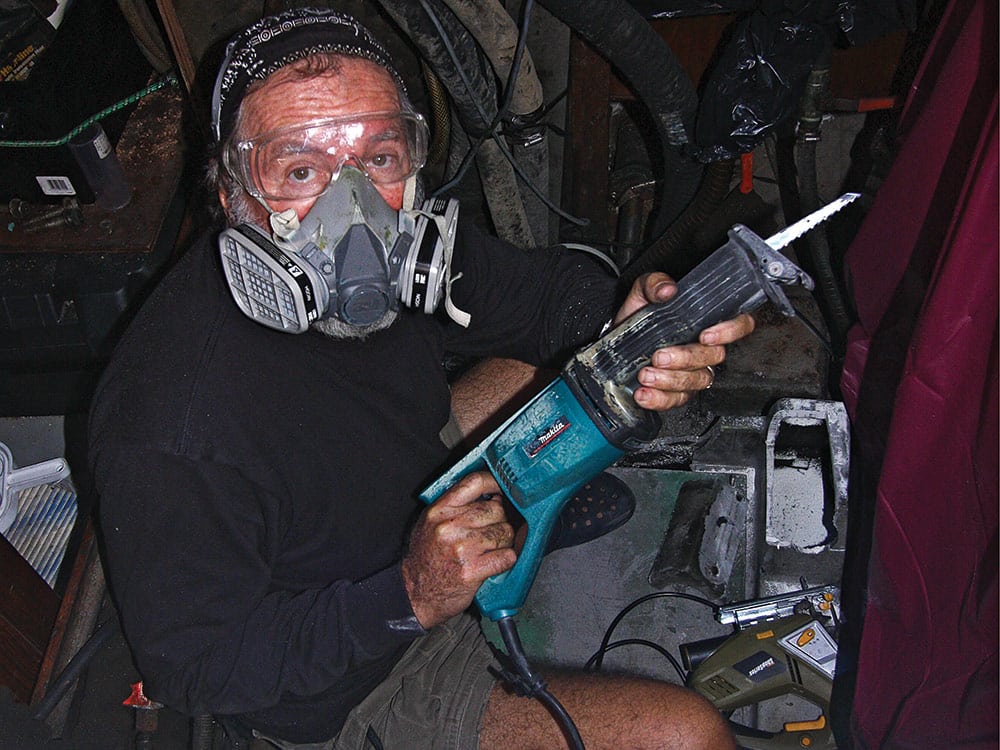
There was an ace “glass mon” on Tortola who happened to end up with a new Beneteau 456 that had its deck burned up by an electrical fire in the headliner. He stowed it in the corner of the boatyard until he could find time to repair it. Later, an identical boat pounded hard on Anegada Reef. He bid peanuts on the vessel and then used a circular saw to cut both boats horizontally along the waterline before fiberglassing the good halves of each back together. He was totally honest with the new buyer on the boat’s history, and the guy learned to live with an interior that’s a micro bit askew!
In Wild Card’s case, when we found her, the prominent damage was just a small area of egg-shelling, or cracking with moderate seepage, around the port turn of the bilge where she’d pounded on the beach. We temporarily patched her, lifted her onto a barge with a crane and took her to Independent Boat Yard, where I cast myself at “de feet of de local glass mon.”

His name was Mike Sheen, and he was horrified when I prostrated myself before him, grabbed his ankles, burst into tears and said, “I’m an idiot! I’ve just spent all my wife and child’s food money on a wrecked boat. Woe is me!”
“Shut up and grind!” he growled.
That’s the key to mending fiberglass: Just bite the bullet and grind until your arms fall off. Grinding is the essential skill.
About two hours into it, Mike came by and said, “See how milky the fiberglass is? Grind it until it is clear, then angle the edge 16-to-1.”
I started to ask a question, but he growled. “Shut up and grind, Fatty!”
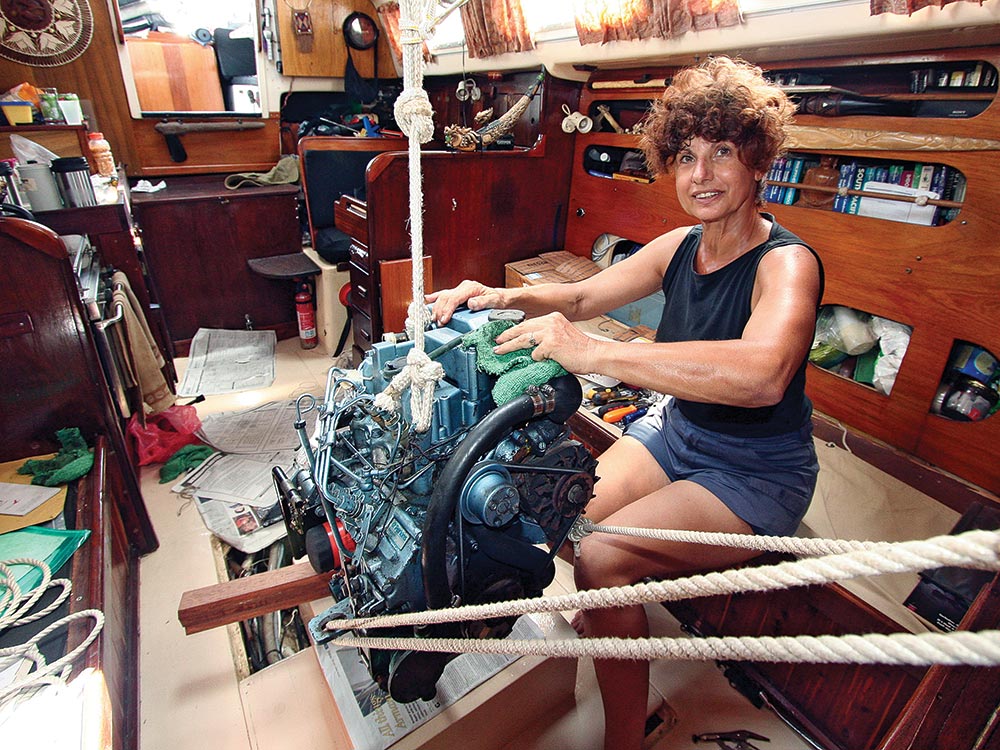
I quickly learned that a hole or wound in fiberglass is like a bullet through a windshield. While the opening is small, the damage is great. Endlessly, I ground away, until our little eggshell wound was 12 feet wide and 3 feet high, and had an actual hole through the hull the size of a basketball.
About 10 days later, I was down to pure fiberglass, with no milky places, and the area was faired with a 16-to-1 angled edge, so there was plenty of raw fiberglass for the new cloth and resin to adhere to.
Time to rebuild. I jammed a piece of waxed Formica inside the boat to keep the proper shape at the hole. Carolyn cut up the biaxial glass, with cloth on one side and mat on the other, in large chunks and placed it on our wet-out board. I slopped polyester resin on the cloth side and flipped it over to wet-out the mat side. Then I placed it over the wetted-out wound and rolled out the bubbles.
You have to work fast. The MEK catalyst makes the resin kick quickly in the tropics. We only put on a few layers at a time to avoid excessive heat buildup or, worst case, having the semi-kicked cloth begin to droop away from the hull. We tried to add new layers on sticky-but-cooling resin to avoid excess grinding. If we allowed the resin to dry, we reground it to ensure perfect adhesion.
Once the outside of the repair was glassed greater than flush with the outside gelcoat, we went inside the boat, built a plastic tent and attacked the entire area with our grinder, then fiberglassed an additional four layers inside.
Glass mon Mike told me during our relaunch, “If you ever hit anything, Fatty, try to hit it on the repaired side. It is much stronger.”
This resulted in what I refer to as a hamburger patch, with a small hole where the patty is and two large overlapping buns inside and out.
Next, we block-sanded the repair on the outside using long, commercially available blocks of the gritty, abrasive material to achieve the fair curve of the hull. Then we finished off the job using West System Epoxy and micro balloons. You cannot see the repair to this day, nearly three decades and 100,000 ocean miles later.
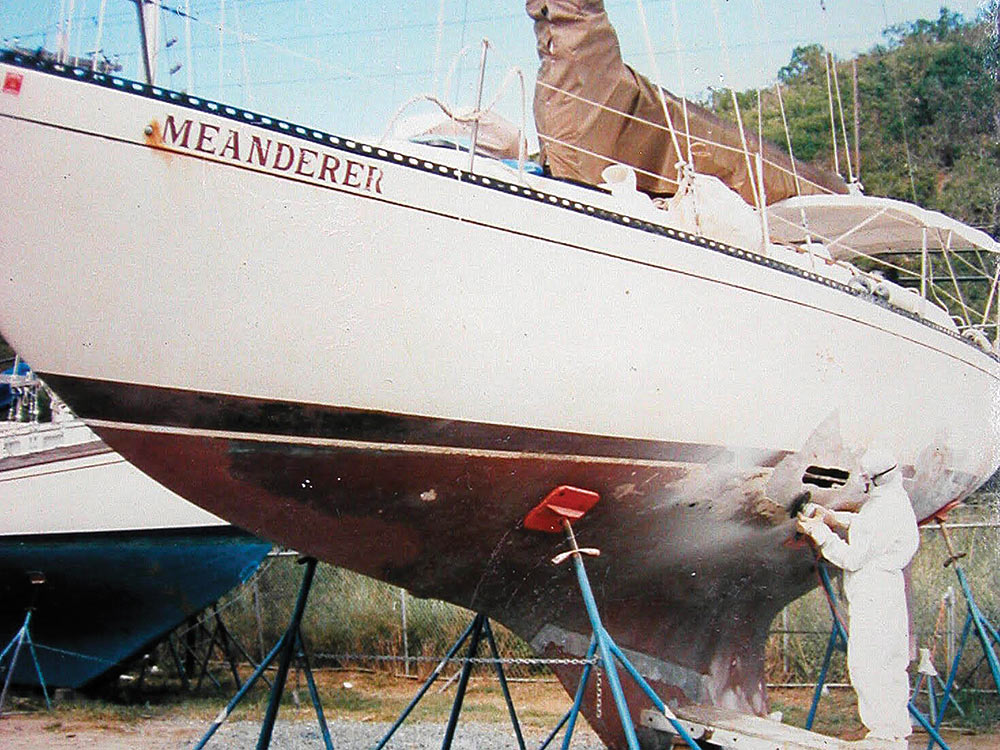
Glass mon Mike told me during our relaunch, “If you ever hit anything, Fatty, try to hit it on the repaired side. It is much stronger.”
When I went to pay him for his consulting work, he waved away my money and said loudly, “Shut up and grind!”
Was it gruesome work rebuilding Wild Card? You betcha. Was it worth it? Oh, yes! For less than $10,000 and 21 days of utter agony, we ended up with an offshore-capable boat worth $50,000 and lots of calluses.
Though we weren’t ready to circumnavigate yet, coming in second in the Coral Bay Thanksgiving regatta was sweet less than a month after we lifted her off the beach.
In the ensuing years, we tossed in a new Perkins diesel and replaced all the electronics as time and money permitted. We improved the boat while still living in paradise, among the nicest, friendliest, most nurturing people in the world.





